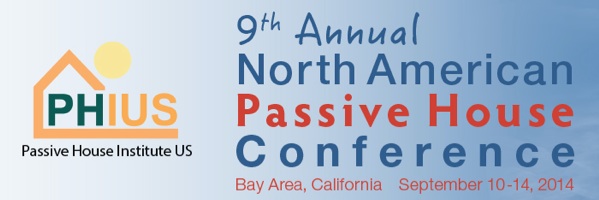5 Reasons to Attend the Passive House Conference in California

The 9th annual North American Passive House Conference is less than a month away. You knew it’s going to be in California, right? It’s unfortunate that the other passive house group has chosen to use the same name PHIUS has been using since 2006, but I’ve already discussed that confusion. All you need to know is that the main passive house conference is in California, not in Maine. And here’s why you ought to get yourself registered for it ASAP.
The 9th annual North American Passive House Conference is less than a month away. You knew it’s going to be in California, right? It’s unfortunate that the other passive house group has chosen to use the same name PHIUS has been using since 2006, but I’ve already discussed that confusion. All you need to know is that the main passive house conference is in California, not in Maine. And here’s why you ought to get yourself registered for it ASAP.
1. Great speakers and presentations
Bill Rose, author of one of my favorite building science books, Water in Buildings, will give the opening keynote address. The smart, funny Achilles Karagiozis will give the closing keynote. Here are a few other notable presenters and presentations:
- Terry Brennan – multifamily QA/QC
- Sam Rashkin, Kat Klingenberg, & Graham Wright – New climate specific standards
- Iain Walker & Brett Singer – ventilation & IAQ
- Chris Benedict – Newest market rate multifamily project in NYC
- Joe Lstiburek – multifamily ventilation design
The breakout sessions are where you get to hear about what’s working and what’s not. Builders, architects, engineers, and certified passive house consultants, all will be sharing their experience with passive house projects they’ve been working on.
2. Pre-conference sessions
I’ll be learning WUFI Passive this year with Prudence Ferreira and Mattias Pazold. Other pre-conference sessions include:
- PHIUS + Rater – Taught by John Semmelhack and Terry Brennan, this designation gets HERS raters involved in passive house projects.
- Domestic Hot Water Design – Gary Klein is the guru of hot water.
- Passive Building Science Fundamentals – Dr. Joseph Lstiburek
With one exception, the cost to attend these sessions is insanely low.
3. Climate specific passive house standards
Do you know what the most frequently given answer is to just about any applied building science question: It depends. The original passivhaus standard, developed in Germany, hasn’t worked so well here in North America, mainly because its rigidity doesn’t hold up to our greater climate variation. Kat Klingenberg did a great job explaining all this in her article at Green Building Advisor earlier this year, so that’s a good place to learn more.
PHIUS has been working with Buildilng Science Corporation to develop climate specific standards and open things up a little bit here. On the first morning of the main conference, those new standards will be unveiled.
4. Dynamic energy modeling
Climate specific standards aren’t the only thing that distinguishes PHIUS from the followers of the German PHI. The main tool of PHI is the Passive House Planning Package (PHPP), which is an Excel spreadsheet with all the calculations you need to model a passive house project. But the PHPP gives you only a static look at what’s going on. WUFI Passive incorporates the hygrothermal modeling of WUFI along with the load calculations necessary for passive house. (Be sure to see Adam Cohen’s quote about PHPP below.)
PHIUS certifies passive house projects using either tool, and you can learn more about the dynamic modeling of WUFI Passive at the passive house conference in California.
 5. We have a pirate!
5. We have a pirate!
OK, Adam Cohen isn’t really a pirate. Anyway, he denied it when Joe Lstiburek asked him if he was one last year at the conference. But he is one smart and committed passive house designer in Virginia. You can read a bit about him in this article by Martin Holladay, which is also where the following quote comes from:
“There are tons of things in the PHPP that I don’t agree with. I know that a building doesn’t work with the PHPP defaults. Energy modeling is 25% science, 25% experience, 25% art, and 25% voodoo.”
What more do you need! The 9th annual North American Passive House Conference is really where it’s at! And of course the Bay Area is a lovely place to visit, too.
See you there!
Related Articles
The North American Passive House Conference Is in San Francisco
Passive House — The Only Place Where Real Innovation Is Happening?
Dr. Joe Lstiburek Surprises Passive House Conference Attendees
NOTE: Comments are moderated. Your comment will not appear below until approved.
This Post Has One Comment
Comments are closed.

Allison, Wish I could make it
Allison, Wish I could make it this year. Looking forward to some great articles – especially interested in hearing what Joe L. and Adam C. have to say. Enjoy learning Wufi Passive – expect it has grown a lot since Prudence walked us through it in Denver.